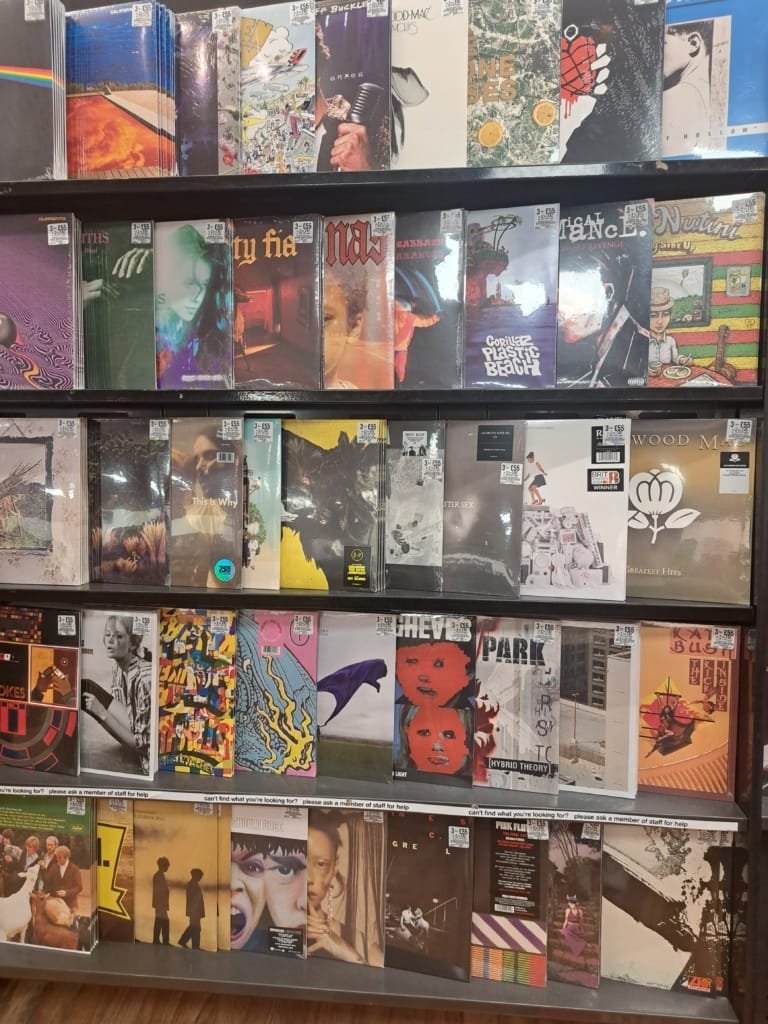When browsing the music section of HMV, I used to spend a long time admiring CDs. Nowadays, I rarely buy them. What is the point? I have my phone and my Spotify Premium account with endless catalogues of music at my disposal. When I go into HMV now, something else grabs my attention. Shelves and shelves of bright, bold vinyl records from Pink Floyd’s Dark Side of the Moon to Dua Lipa’s 2024 album Radical Optimism. I experience an impulse I have never felt before: I want to buy a vinyl.
My interest in vinyl records reflects the new renaissance of vinyl culture which has been emerging over the past decade. After a slump in sales between the 1990s and the early 2000s, purchases of vinyl records have risen for the sixteenth consecutive year. By the end of 2023, 5.9 million vinyl records were sold in the UK. This rapidly growing market is increasingly driven by the under 25 demographic who are seeking physical copies of their music and discovering vinyl for the first time.

With globally acclaimed singers topping the 2024 vinyl charts such as Taylor Swift’s The Tortured Poets Department and Ariana Grande’s Eternal Sunshine, artists are recognising the vinyl as a musical product worth investing in. Vinyl has weathered the challenges of cassettes, CDs and the domination of streaming services. What is it about the vinyl which has audiences coming back for more?
Why Vinyl?
A Musical Experience
Vinyl offers listeners an alternative, active, sensory musical experience and creates an intimate bond between a consumer and their favourite artists. While platforms like Spotify offer an easy and convenient service, vinyl transforms the casual enjoyment of music into a special occasion which requires preparation, effort and time. Buying a vinyl record is a financial and emotional investment in an album and its musical artist. It requires you to evaluate whether a record holds enough personal importance for you to spend money on. Unlike pressing a button on a CD player or a smartphone, necessary steps must be completed to listen to an album on vinyl such as setting up the turntable and adjusting it to ensure it plays properly. The work undertaken to enjoy the music assures the consumer’s attention is focused on the music itself and strengthens the connection between the listener and the album.
Can Appreciate the Art of an Album
Listening to an album carefully and chronologically on vinyl with few to no skips allows you to fully appreciate the musical production and lyrical talent of the artist. By journeying through the track list in order, the listener is exposed to the full scope of an artist’s creativity and innovation and can truly understand a singer’s musical intent.
Sensory Satisfaction:
The tactile, visual and auditory dimensions of the vinyl combine to create an immersive and stimulating listening experience. The vinyl’s tangibility as the record is handled and touched creates precious memories for the consumer and allows them a sense of ownership over the music. The vinyl also has an aesthetic appeal with its vivid, eye-catching, elaborate artwork and large surface area, the vinyl serving as both a musical and artistic product which can be displayed and admired. Releasing the same album in multiple colours with limited edition, exclusive designs encourages collectability and attracts fanbases who use their vinyl records as an expression of their admiration for a particular musical artist. The vinyl is a product which engages all the senses and cultivates a special, personal bond with musicians and their releases.
Unique, Authentic Sound:
Collectors have long proclaimed the vinyl’s superior sound quality. Whilst digital audio possesses a full frequency which goes beyond human capability, listeners of vinyl records are attracted to its raw, warm sound. They enjoy hearing the subtle imperfections and nuances of the artist’s voice that digital production corrects. Every listener will have their individual sound preferences, some opting for the clean and crisp quality of digital audio over crackles and pops from degrading records and low-quality equipment. What vinyl offers is a chance to hear music as close to the original recording as can be achieved, music in its most authentic form.
Is vinyl the future?
The surging sales of vinyl records over the past decade demonstrates the enduring public affection for the vinyl as a form of music consumption and as a physical, aesthetic product. Whilst vinyl is unlikely to ever reach the heights of streaming, vinyl has carved out its own smaller but important place in the music industry. Vinyl provides music enthusiasts with a nostalgic, artistic product connecting them with their favourite artists and a physical piece of memorabilia. As consumers increasingly buy vinyl records without owning a player, this leads to the question whether the vinyl’s future lies in its value as a piece of visual merchandise and if its true purpose as a medium of playing music will be lost over time.
From Vinyl to EcoVinyl?
Vinyl must adapt to changing consumer attitudes as shoppers seek to be more environmentally conscious. The main material of traditional vinyl is the plastic PVC which is hugely polluting and damaging to the environment. As the popularity of vinyl rises and production increases, so will the prevalence of PVC. In April 2024, Billie Eilish announced the vinyl copies of her third album Hit Me Hard and Soft would be made from recycled vinyl or an eco-alternative BioVinyl which reduces carbon emissions by 90%. Following her example, other artists will need to consider the ecological impact of their physical music records. Manufacturers will need to search for green, low-impact production methods to reflect the increasing demand for eco-friendly products and ensure the music industry is a leader in sustainable practices.
Conclusion:
Vinyl has a promising, exciting future as forecasters project another year of record-high UK sales. As big industry players produce vinyl in large volumes, it must be ensured that small, independent artists benefit from this booming market and are not squeezed out by companies with larger orders and financial resources.
Audiences remain captured by the vinyl’s aesthetic beauty, its unique sound and collectability, listeners continuing to seek tangible copies of music they can own and engage with. The longevity of the vinyl’s lifespan shows even with the convenience of streaming services, physical music continues to be prized and precious.


